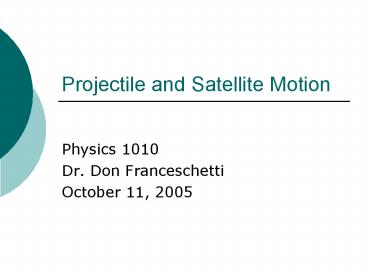Projectile and Satellite Motion - PowerPoint PPT Presentation
1 / 16
Title:
Projectile and Satellite Motion
Description:
A projectile is any object that is projected by some means and ... Kinetic energy is greatest, speed is hight. Perihelion, aphelion, apply to planet and Sun ... – PowerPoint PPT presentation
Number of Views:484
Avg rating:3.0/5.0
Title: Projectile and Satellite Motion
1
Projectile and Satellite Motion
- Physics 1010
- Dr. Don Franceschetti
- October 11, 2005
2
Projectiles
- A projectile is any object that is projected by
some means and continues in motion by its own
inertia. - Main classes are weapons bullets, arrows,
artillery shells, bombs, rocks and balls
baseballs, footballs, golf balls
3
Projectiles
- Are in free fall, neglecting air resistance
- The horizontal component of velocity does not
change because the net force acting has zero
horizontal component - The vertical component changes in response to the
gravitational force.
4
Projectile motion by superposition
- Projectiles launched horizontally
- Upwardly launched projectiles
- Range is same for angle and complementary angle.
- Greatest range for projectiles launched at 45
degrees.
5
Fast moving projectiles satellites
- Circular orbits
- Near earth 90 minute period
- Orbital sped 8km/s, near Earths surface
- Geosynchronous, 24 hour period, orbital speed is
less - Elliptic orbits
- Keplers laws apply
6
Keplers laws
- Tycho Brahelast of the great naked eye
astronomers, recorded planetary positions every
night for years and years. - Kepler, mathematician tried to explain Brahes
data, came up with
7
Keplers 3 Laws
- Orbits of planets are ellipses with sun at one
focus. - The line connecting the sun and each planet
sweeps out equal areas in equal time. - The square of the period of a planet is
proportional to the cube of the semimajor axis.
8
Newton
- Orbits of planets are ellipses with sun at one
focus. (laws of motion plus law of universal
gravitation) - The line connecting the sun and each planet
sweeps out equal areas in equal time.
(Conservation of Angular momentum) - The square of the period of a planet is
proportional to the cube of the semimajor axis.
(laws of motion plus law of universal
gravitation)
9
Energy Conservation and Satellite Motion
- Terminology
- Apogee, most distant point from Earth
- Potential energy is greatest
- Kinetic energy is least, motion is slowest
- Perigee, closest approach to Earth
- Potential energy is least
- Kinetic energy is greatest, speed is hight
- Perihelion, aphelion, apply to planet and Sun
10
Escape speed
- Minimum speed needed to escape planet
- from Earth is 11.2 km/s.
- From Sun at Earth orbit is 42.2 km/s
- Pioneer 10 left Earth in 1972 at 15km/s used
gravitational assist from Jupiter.
11
Review
- Q10.5 A rock is thrown upward at an angle. What
happens to the horizontal component of its
velocity as it rises? As it falls? - Q10.6 A rock is thrown upward at an angle. What
happens to the vertical component of its velocity
as it rises? As it falls?
12
Review
- Q 10.14 Are the planets of the solar system
simply projectiles falling around the sun? - Q 10.18 Why does the force of gravity change the
speed of a satellite in an elliptical orbit.
13
Review
- Q10.25 Why is the kinetic energy a constant for
a satellite in circular orbit? - Q 10.26 Why is kinetic energy a variable for a
satellite in an elliptical orbit?
14
Review
- E10.4 In the absence of air drag, why does the
horizontal component of a projectiles motion not
change, while the vertical component does? - E10.9 When a rifle is being fired at a distant
target, why isnt the barrel lined up so that it
points exactly at the target?
15
Review
- E10.15 Since the moon is gravitationally
attracted to earth, why does it not simply crash
into the Earth? - E10.16 When the space shuttle coasts in a
circular orbit at constant speed about the Earth,
is it accelerating? If so, in what direction? If
not, why not?
16
Review
- E10.18 Does the speed of a falling object depend
on its mass? Does the speed of a satellite in
orbit depend on its mass?































